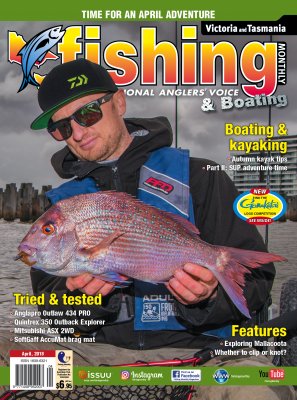Do you clip or do you knot? by Jarrod Day
 I'll probably cop a bit of flack for this comment but while I get older and rounder as the years pass, some things in fishing become a little more challenging - not that I'm that old and sure the mind might still think like an excited eighteen-year-old, but the fingers just don't get into place like they used to.
I'll probably cop a bit of flack for this comment but while I get older and rounder as the years pass, some things in fishing become a little more challenging - not that I'm that old and sure the mind might still think like an excited eighteen-year-old, but the fingers just don't get into place like they used to.
Removing any naughty connotations from that sentence, I mean tying complicated knots as you age can start to become a little more of a challenge. Shaking hands, fading eyesight and not being able to understand how to tie specific knots makes it much more difficult and can be off-putting to some people.
In today's era of technology there are many more options for anglers than just tying complicated knots, especially if you're not confident in tying one securely. A lot of anglers these days are quite apprehensive about their knot tying ability and I guess a lot of it comes down to not wanting to lose a fish let alone a fish of a lifetime.
Knot tying takes practice and unlike learning something important for your main income earning, mastering a part of something for your hobby really doesn't seem that important a lot of the time. This is totally understandable, and this situation can be broken up into two categories: those that dangle and those that angle.
If I was to go along with the saying '10% of anglers catch 90% of the fish,' then you can understand that those who put more into the sport, get more out of it. Anglers who fish on the odd weekend here and there tend to be less confident in their own tying ability.
Learning knots can be frustrating at the best of times for anglers of all levels of experience and for a few reasons. Firstly, braid, monofilament and leader material don't stay still for you, especially when it's windy or the diagrams in knot books are hard to understand, let alone if you're trying to keep up with a pro on a YouTube clip as they tie some far out, whiz-bang knot in around ten seconds! Sometimes it just gets too hard. In saying that, if you can at least learn one knot, then the rest will all fall into place.
BASIC KNOTS
Amongst the plethora of fishing knots, when to use them and how to tie them, I really believe we often over-complicate fishing. Don't get me wrong, I have caught and tangled with some of the country's most brutal GTs, kingfish, barra, Murray cod, trout, snapper, samsonfish, tuna and the like but I'm not one for looking into breaking strains of lines and what knot will hold for a particular species and so on. I use the KISS approach - Keep It Simple, Stupid. Fishing is fishing; if you look too far into it, you lose the fun and excitement.
I still remember being 10, sitting at the Portsea Pier during the September school holidays. The grass whiting were in plague proportions then, and after my mate and I ran out of bait, we were threading on dried seaweed that was on the pier to use for bait and in one instance moulded a small piece of tin foil we found in the pier's crack around the hook and continued catching them.
Rex Hunt was on the pier that day filming - it must have been 1988. He came up to me and showed me a knot; I think at the time we used granny knots to attach the hook to the line. I still remember the 'blood knot' and as a young grasshopper, learnt the locked blood knot, which held better. In my teens I began targeting larger fish and lost a few with the end of the leader coming back with what looked like a pig's tail - the classic sign that the knot had slipped.
This made me rethink my knot tying ability and I quickly learnt the three-turn uni knot. To this day, the three-turn uni knot is still my most reliable knot to tie and I haven't had it slip. Along with this and the introduction of technology, today I have limited myself to just a few knots that I have 100% confidence in as well as specialised metal clips in many situations that I know won't fail.